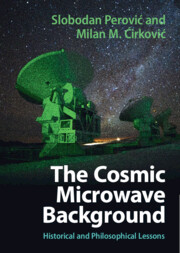Book contents
- The Cosmic Microwave Background
- The Cosmic Microwave Background
- Copyright page
- Epigraph
- Contents
- Acknowledgments
- Introduction
- Part I Physical cosmology: A brief introduction
- Part II Discovery of the CMB and current cosmological orthodoxy
- Part III What constitutes an unorthodoxy? An epistemological framework of cosmology
- Part IV Moderate unorthodoxies: The CMB with the Big Bang
- 11 Cold and Tepid Big Bangs
- 12 Models with unresolved sources
- 13 Thermalization by grains, the first wave
- 14 Primordial chaos
- 15 Early intergalactic medium, massive Population III objects, and the large-numbers hypothesis
- 16 Late thermalization of starlight
- 17 “An excess in moderation”
- Part V Radical unorthodoxies: The CMB without the Big Bang
- Part VI Formation of the orthodoxy and the alternatives: Epistemological lessons
- Part VII Other philosophically relevant aspects of the CMB
- Book part
- Notes
- References
- Index
15 - Early intergalactic medium, massive Population III objects, and the large-numbers hypothesis
from Part IV - Moderate unorthodoxies: The CMB with the Big Bang
Published online by Cambridge University Press: 09 July 2024
- The Cosmic Microwave Background
- The Cosmic Microwave Background
- Copyright page
- Epigraph
- Contents
- Acknowledgments
- Introduction
- Part I Physical cosmology: A brief introduction
- Part II Discovery of the CMB and current cosmological orthodoxy
- Part III What constitutes an unorthodoxy? An epistemological framework of cosmology
- Part IV Moderate unorthodoxies: The CMB with the Big Bang
- 11 Cold and Tepid Big Bangs
- 12 Models with unresolved sources
- 13 Thermalization by grains, the first wave
- 14 Primordial chaos
- 15 Early intergalactic medium, massive Population III objects, and the large-numbers hypothesis
- 16 Late thermalization of starlight
- 17 “An excess in moderation”
- Part V Radical unorthodoxies: The CMB without the Big Bang
- Part VI Formation of the orthodoxy and the alternatives: Epistemological lessons
- Part VII Other philosophically relevant aspects of the CMB
- Book part
- Notes
- References
- Index
Summary
Sir Martin Reese’s second model of 1978 was another Population III (pre-galactic stellar) explanation but with the motivation of deriving the photon-to-baryon ratio from known astrophysical processes. As the chapter explains, this motivation was interconnected with concerns about fine-tuning physical constants and cosmological parameters to enable a habitable universe. The non-primordial origin of the CMB Reese worked out with Bernard J. Carr was driven by adherence to the simplicity of a hypothesis. He expressed sympathy with Paul Dirac’s hypothesis of large number of coincidences that established relations between the age of the universe and atomic units, the gravitational constant and cosmic time, and the number of nucleons and cosmic time in terms of large dimensionless numbers. Dirac turned his initial hypothesis into a full-fledged but unusual and intriguing variant of the Big Bang model. The chapter presents some discussions of the model with respect to the precision of the measurements of the CMB.
Keywords
- Type
- Chapter
- Information
- The Cosmic Microwave BackgroundHistorical and Philosophical Lessons, pp. 91 - 97Publisher: Cambridge University PressPrint publication year: 2024

